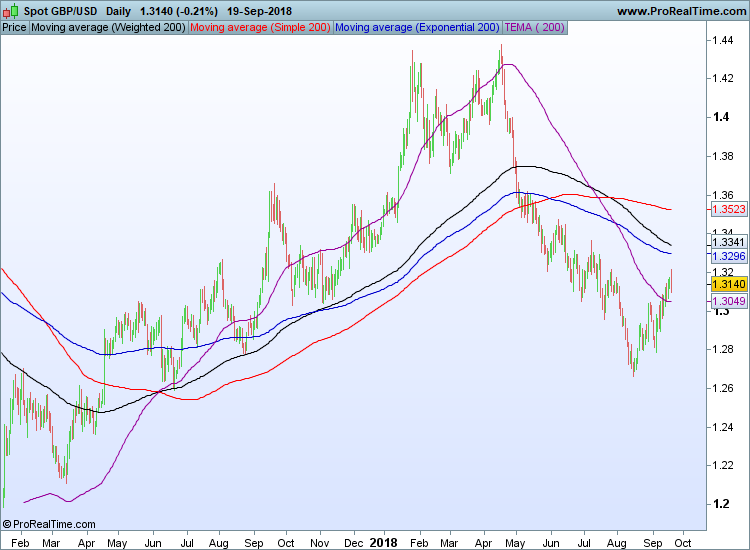Introduction To Moving Averages
Moving averages are extremely useful because regardless of which one you use, you can instantly add them to your chart to see if a particular forex pair is trending upwards, downwards or sideways.
By using different period settings, such as 5, 50 and 200, for instance, you can identify the short, medium and long-term trends really easily, and you can also trade any moving average crossovers that occur because when a short-term moving average crosses above or below a longer-term moving average, it often indicates a change of trend.
For example, some people like to enter trades when a 5-period moving average crosses above or below a 20-period moving average, whilst long-term traders who trade off the daily charts, for instance, will often prefer to take a position when the 50-day moving average crosses above or below the 200-day moving average.
The problem that many forex traders face is knowing which moving average is the best one to use because a lot of charting software will often include many different variations, such as simple, exponential, weighted and triple exponential moving averages.
So in this article I want to discuss some of the key differences between each one and reveal which one I like to use the most.

(GBP/USD daily chart with 200-day moving averages: SMA, EMA, WMA, TEMA)
Simple Moving Average (SMA)
As the name suggests, the simple moving average is one of the easiest to use, and the easiest to understand. That’s because it basically derives an average price by dividing the total of the closing prices of the previous periods by the total number of periods.
So in other words, a 200-day simple moving average will give you an average closing price from the previous 200 days, and a 20-period SMA on a 1-hour chart, for example, will give you an average price from the previous 20 hours.
This particular moving average is said to be the most popular one amongst traders and investors, but because it assigns equal weight to each period, it does have its limitations.
Exponential Moving Average (EMA)
The exponential moving average improves upon the simple moving average because the calculation of the EMA gives more weight to recent prices than historic prices.
Therefore it reacts a lot quicker to recent price changes, and alerts you to a change of trend a lot quicker than the simple moving average, which is very much a lagging indicator.
For these reasons, the EMA is also one of the most popular moving averages amongst forex traders and stock market investors.
Weighted Moving Average (WMA)
The weighted moving average is similar to the exponential moving average because it also gives more weight to recent prices than historic prices.
The only difference is that the calculation is slightly different, but if you apply both the WMA and the EMA to your price charts (or take a look at the chart of the GBP/USD above), you will find that they give similar readings and both alert you to changes in trend fairly quickly in comparison to the SMA.
However the weighted moving average will alert you to changes in trend slightly quicker than the exponential moving average, which is why some traders prefer to use the WMA instead of the EMA.
Triple Exponential Moving Average (TEMA)
The triple exponential moving average is calculated using a complex formula, and is basically designed to smooth out volatility and reduce the lagging nature of traditional moving averages, like the ones previously mentioned.
The EMA and WMA are both very useful, but they are still lagging indicators to a certain extent. However if you add the TEMA to your charts (if you have access to this indicator), you will see that this indicator follows the price action really closely and responds to trend reversals extremely quickly.
The Best Moving Average Is….
It is hard to say that one particular moving average is better than all the others because it largely depends on your overall strategy and the time frame that you like to use.
There is very little difference between each one when using short-term moving averages, but the difference is more noticeable when using 100 or 200-period moving averages, for example.
It could be argued that the SMA is the least useful because it is simply too slow to reflect price changes and trend reversals, whereas the TEMA is the best one to use because it is the quickest to reflect price changes.
However in my opinion, the best moving average to use is the exponential moving average because I have always found the crossovers to be very profitable and I know that it is used by many other traders, which by itself creates opportunities because the EMAs will often act as key levels of support and resistance, and can be used to set your price targets and stop losses.
Do you have a favorite moving average that you like to use yourself? If so, please post a comment below.

Leave a Reply